Hawthorn berry harvesting is a new one for me this year. They are sweet and mild if you get them at just the right time, and in past years I was tasting them too early in fall. This year, Washington hawthorn was sweet and mild in late October. But by that time, single-seeded hawthorn was beginning to rot, so next year I’ll look for those in mid-October.
I owe some credit to Josh Fecteau’s recent hawthorn post, which inspired me to try hawthorn berries again. As Josh points out, there are many hawthorn species, perhaps 50 in New England. And, in all of North America, possibly a thousand species, according to George Symonds (from his wonderful book Tree Identification Book : A New Method for the Practical Identification and Recognition of Trees, my favorite guide for learning tree ID). Fortunately, you don’t need to be able to identify particular species. You just need to know it’s a hawthorn, because all hawthorns have edible berries. HOWEVER, like apple seeds, hawthorn seeds contain cyanide, and should not be eaten. Don’t panic; just spit out the seeds.
Why bother with hawthorns? They are beautiful, interesting, and tasty wild edibles with known health benefits. Some people use the berries to make hawthorn jelly, but I have yet to try this. Berries, leaves and flowers can be used to make a tea. Scroll down to the bottom of the page to see how I am making hawthorn berry extract.
I’m going to describe two species here, to exemplify the general characteristics. That should help you recognize a hawthorn when you see one, but if you are uncertain that you have a hawthorn when foraging, please check with additional sources until you ARE certain, before eating the berries.
Washington Hawthorn, Crataegus phaenopyrum
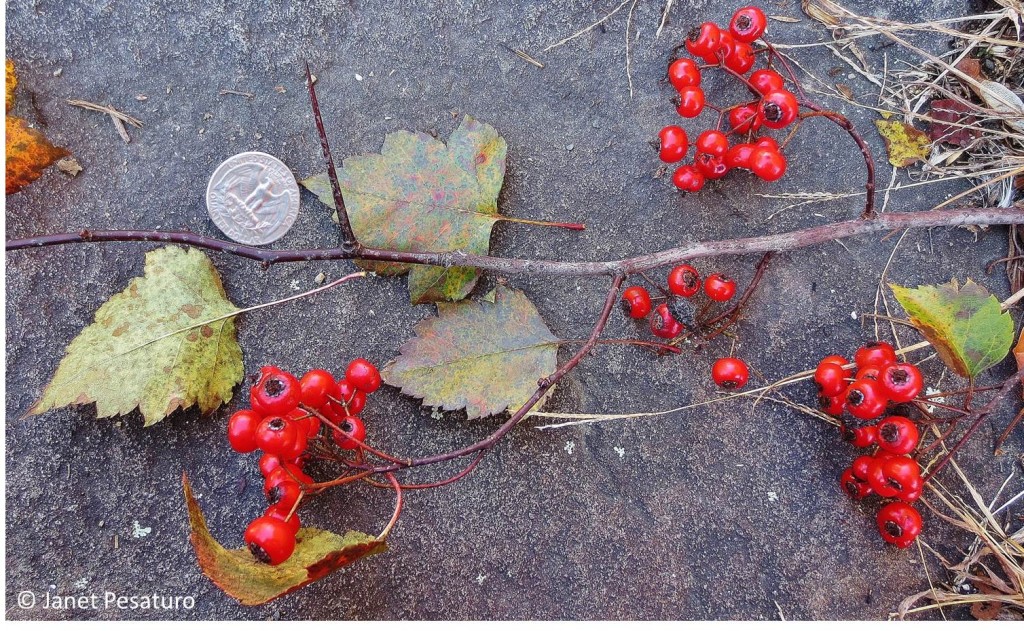
Washington hawthorn (Crataegus phaenopyrum): berries, leaves, thorns in early November. Coin for scale.
This grows as a small tree or large shrub, and bears clusters of white flowers in late spring. The berries turn red in September (here), but sweeten later. By October 31st, they were sweet, and maybe slightly past peak. Each berry has 3-5 seeds.
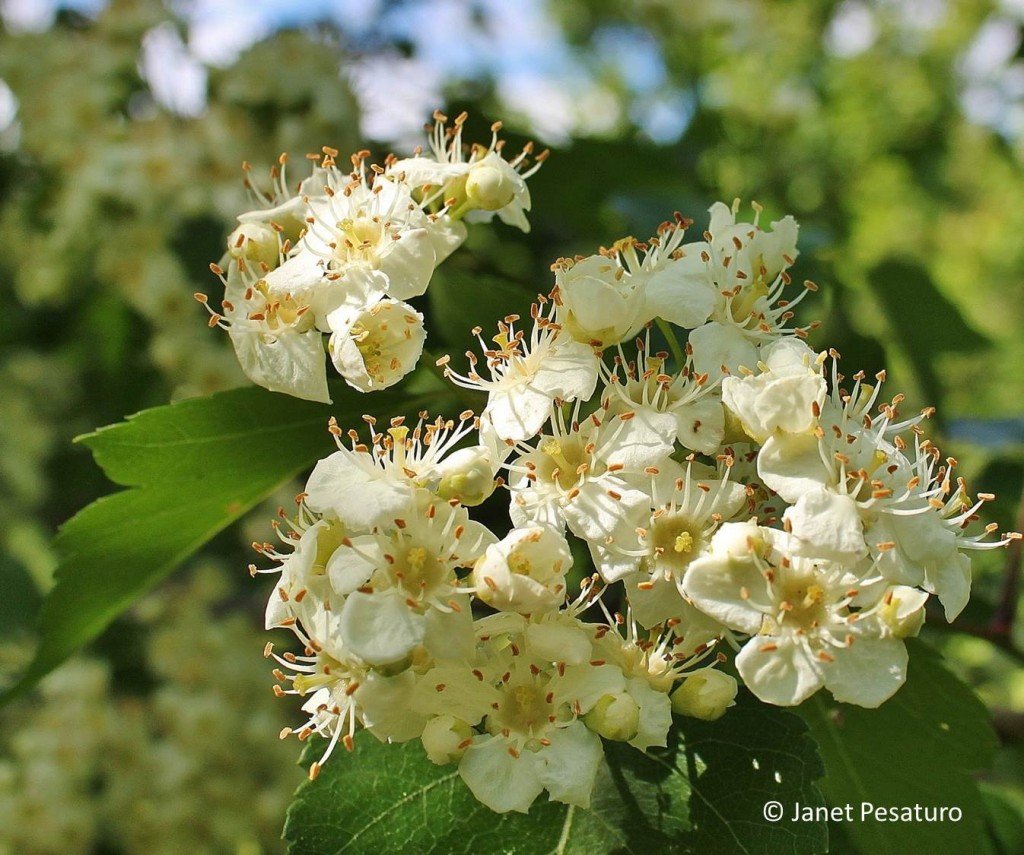
Hawthorn Berries: Identify, Harvest, and Make and Extract. Photo shows flowers of Washington hawthorn.
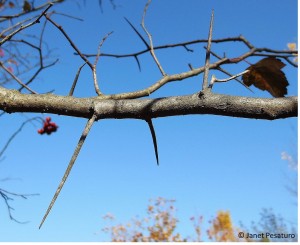
Washington Hawthorn: Identify, Harvest, and Make and Extract. Photo shows thorns of Washington Hawthorn.
The leaves are lobed and toothed, as you can see in my photo above. Many other hawthorn species have similar leaves. The tree is heavily armed with long thorns, up to about 3 inches in length. However, with reasonable caution, you can easily harvest the berries, which tend to hang away from branch. It’s even easier later in the season after many of the leaves have fallen and no longer obscure the thorns.
Single-seeded hawthorn, Crataegus monogyna
Also called common hawthorn, this is a European native which has escaped cultivation and naturalized in North America. It is sometimes branded as an invasive plant, but I don’t find it very often, and when I do see it, there isn’t a lot of it in one area. Perhaps it is invasive in other parts of the country, but it does not seem to be particularly aggressive here. Like Washington hawthorn, single-seeded hawthorn grows as a shrub or small tree, and bears clusters of white blooms in late spring. The oval red berries ripen a little earlier (than Washington hawthorn) in fall and contain a single seed (hence the name). The toothed leaves are more deeply lobed than those of Washington hawthorn, but the thorns are much smaller, only about 1/2 inch to an inch in length.
Summary of hawthorn characteristics
- Grows as small tree or shrub
- Smallish, toothed leaves which are lobed to varying degrees
- Thorns which vary in size, depending on species
- Clusters of flowers (usually white, but some species have pink or red) in spring
- Clusters of edible red berries in fall
- Berries contain one or more seeds which should not be consumed due to cyanide content
- Fruits most prolifically in sunny spots
Where to find hawthorn berries
Hawthorns are common in the forest understory here in Massachusetts, but those are scrawny specimens which do not fruit well. It’s too shady in the forest. To find fruit laden hawthorns, look in sunny spots, such as shrubby fields and thickets, at pasture edges, and along streams. They are often planted as ornamentals, so if your friend has one and doesn’t mind you picking some berries, you have an easy foraging experience at your fingertips.
Make hawthorn berry extract
This is my first experience using hawthorn berries, and I am using them to make an extract, with the same process you would use to make vanilla extract. I hope to use hawthorn extract as a flavoring in cooking and baking. I filled a clean canning jar about 3/4 full with berries, covered them with 80 proof vodka, and capped the jar. I am not sure how long it will take to extract enough flavor from the berries, so I will be checking it daily. I know that other extracts, (such as vanilla extract) take weeks, so that’s what I’m expecting here.
Sources consulted for species identification:
These are the authoritative sources for plant identification in the US.
- Manual of Vascular Plants of Northeastern United States and Adjacent Canada
- Illustrated Companion to Gleason and Cronquist’s Manual: Illustrations of the Vascular Plants of Northeastern United States and Adjacent Canada
Shared on:










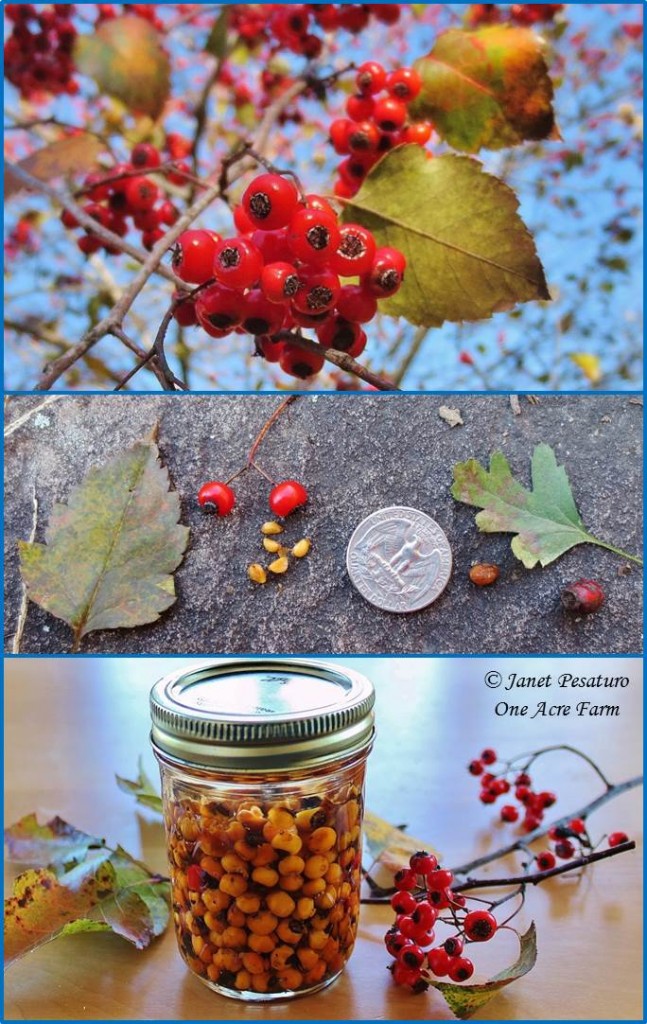
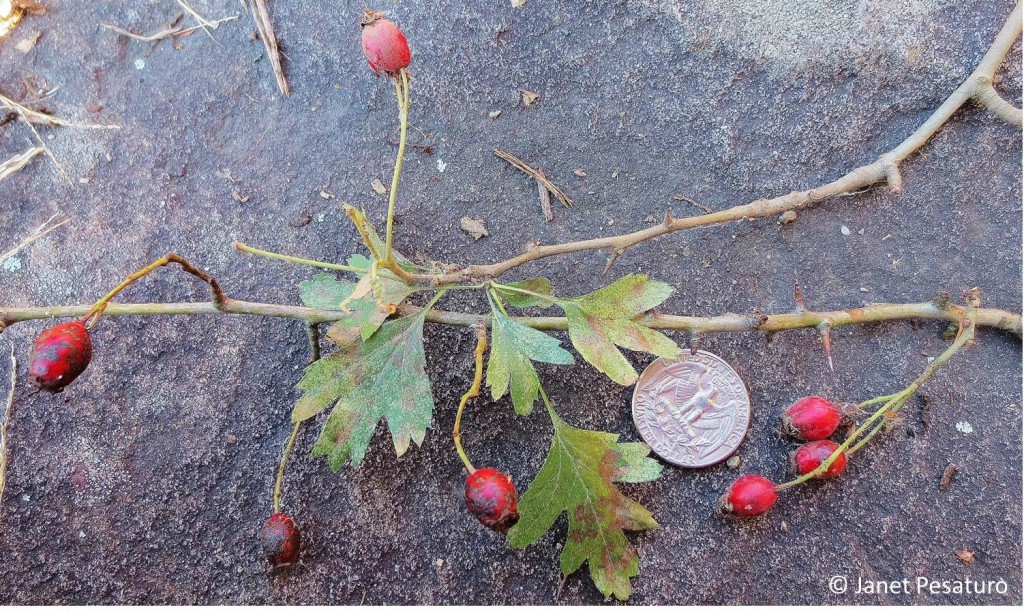
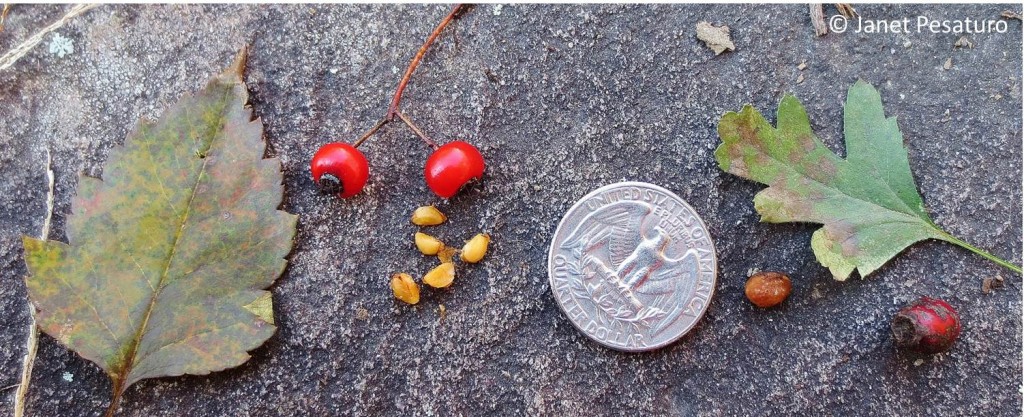
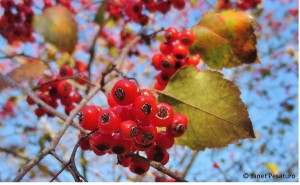
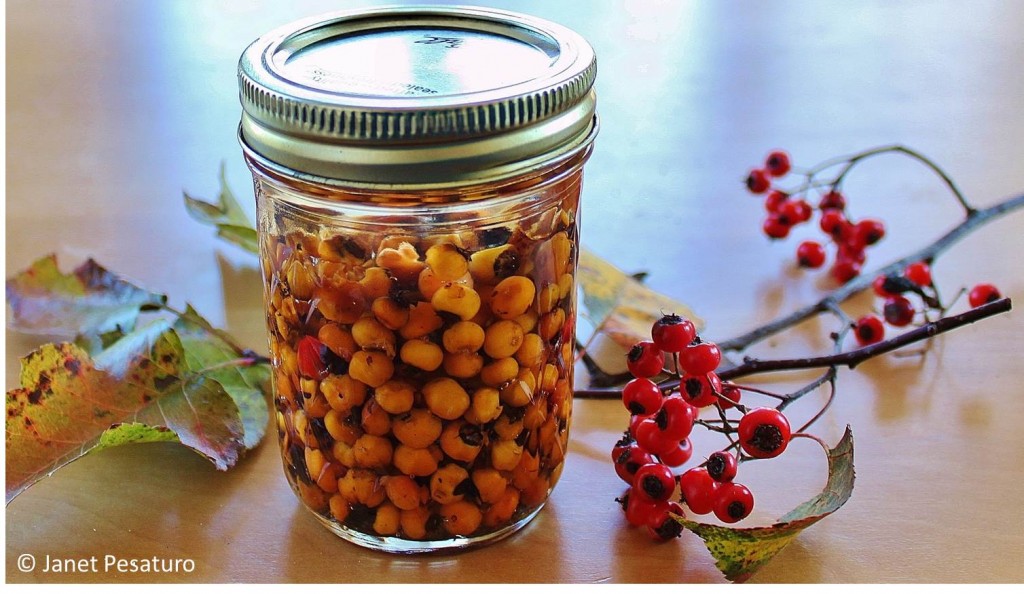
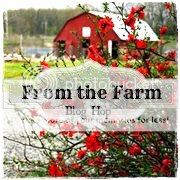
I wonder if we have them around here ( Western PA ) This was very interesting! 🙂 I ‘ll have to Google and see if we do but if we do they must be uncommon / while I have heard of them, I have not really heard of anyone doing anything with them locally…but learn something new every day ! 🙂
Thanks for your comment on my Hawk post..I’d not have known if it was an adult or juvenile without your comment : ) They fly around ( I see them coasting in the skies and hear them often ) but it’s the first close-up visit that I have had.
Thanks for stopping by, Deb! – the first comment on any post is always exciting – like opening a Christmas present, LOL!
Bet you do have hawthorns out there. They’re very common, and once you learn to recognize them, you’ll be amazed how often you see them.
Hello, I found you on the Natural Living Link-up. I LOVE hawthorn! I have been sneaking hawthorn into my dad’s teas and foods (with my mom’s help) for a few years now because he has heart issues. Thanks for the information and the beautiful pictures! I loved how you used a quarter to show the size of the berries! That was genius. 🙂
Raven, how cool! I would love to know how you use it – do you use leaves or flowers for tea? What part of the plant do you add to foods? Thanks for stopping by!
Great post!
Thanks for sharing it with us at the HomeAcre Hop!
Sandra
http://www.mittenstatesheepandwool.com
This was great – I love Hawthorn and Mountain Ash (very similar)! We shared this with our FB readers at homesteadlady.com.
Thank you VERY much Tessa, for sharing it on fb!
Oh my, I love this post. Like you said it’s amazing how many wild plants have edible parts. Wild foraging is the best. Love your blog!
Thank you so much. We have hawthorns here and I love using wild plants for jellies and extracts. This was extremely informative. I can’t wait to try these ideas next year.
Great information! I love your blog – it’s so pretty!
I have tentatively identified a tree on our property as hawthorn, although I want to confirm before I consume any of the berries. It’s BEAUTIFUL this time of year with so many red berries on this one tree it almost looks like a red tree from a distance! Thank you so much for sharing this post (visiting from FarmGirl Friday hop)
~Taylor-Made Ranch~
Wolfe City, Texas
Learned from a naturopath treating my wheezy 4yr old that hawthorne extract taken as a tincture in 1/4 tsp doses every 10-15 minutes until symptoms subside will open the airway. It can ward off asthma attacks if taken at first signs. Also, my 9 year old has been suffering from a terrible bronchial cough after flu for the past several days that has made sleep difficult. Remembering hawthorne and wheezing success, I decided to try it. 2 doses later, she is sleeping soundly and not coughing. There are no side effects, except that is is a mild sedative (along the lines of chamomile) which is a plus for us. Online, there is no information on its benefits for breathing support, but I am convinced. Thanks to Dr. Pais, Whom I have learned this from years ago….We will attempt making our own extract this summer as bushes flower and fruit. Until then, I have some liquid available from Emerson Ecologicals. Only place I found it in liquid form.
Very interesting, thanks for sharing your experience. We really need more studies on the medicinal properties of hawthorns and other common plants!
Here in Oregon, I find (common) hawthorn extremely invasive. Have spent the last decade trying to eradicate it from my property. The thorns are extremely painful, and seem to leave something behind, even when you pull them out of your skin, leaving a painful “ache” in your muscles that last for a long time. I routinely curse the person that introduced them to my area. After reading your article, will have to try making an extract similar to your method. Are there other methods of use, such a fruit leathers, dried powders, jellies that prove useful. How do you use your extract after it is made, (a few teaspoons in a night time chamomile tea?)
Hi John, yes! there are other ways to use hawthorn berries! If you haven’t already, try googling recipes for hawthorn berry jelly and fruit leather, and you won’t come up empty handed. The extract has a pleasant flavor and I add to cookies and quick breads. It is mild though, and you need to let the berries sit in the alcohol for several months.
Very interesting that common hawthorn is highly invasive in Oregon. It is not very aggressive here, but I do recall reading that it is invasive in some areas. I hope you’re able to make some good use of this plant. If you do used the berries, you will at least reduce the spread of the plant. Good luck!
Interesting. I’m in Portland, OR, and just harvested a gallon of common Hawthorn berries from Mount Tabor. (single large seed, short thorns = common Hawthorn) There are over a dozen in one area, so it makes sense that they might be invasive. I didn’t find the thorns to be bothersome, though. I did get lightly pricked a few times but the bark was worse than it’s bite! Much more painful was the prick from the invasive blackberry growing in the same area.
The berries I harvested today were dry and bland. Not sweet, not tart, very little flavor (though a hint of apple).
My current plan is to let the berries sit in bourbon and fish out a spoonful a day for medicinal use, chew them whole, then spit out the seeds. Seems easier than making jelly. And at the end, I’ll have a tincture, but I don’t expect any flavor from these berries, hence bourbon instead of vodka.
Thanks for the great info and ideas!
Sounds like they were a little past peak when you picked them,although they are not strong in flavor even when at peak.
Hawthorn is primarily known as a cardiac tonic. It can help heal the damage done to the heart after a heart attack, strengthens arteries, and helps lower elevated BP. However, for those benefits, you would need to make your tincture a bit differently, as you’d be looking to extract the chemical constituents. Using fresh berries, you’d want to use something more like grain (not iso) alcohol, like Everclear. The alcohol extracts not only the alcohol soluble constituents, but it also draws water out of the berries, taking the water soluble constituents with it as well. 80 proof vodka has too high of a water content to do that as effectively. Another option would be to dry the berries, and then use the vodka to extract.
Yes I know some people use it as a cardiac tonic, but that was not my intention here. I use it for flavoring. I personally would not use hawthorn as a “cardiac tonic” and would not recommend it as such. It hasn’t been adequately studied enough for those purposes, imo, and dosing a homemade concoction is pure guess work.
I understand that wasn’t your intent. I do appreciate your interest as only a flavoring. However, as a practicing herbalist, I have to point out that you’re incorrect about there not being adequate studies or about dosing being guesswork. It’s been written about and its efficacy documented extensively in very biomedically-oriented texts such as Principals and Practice of Phytotherapy, Medical Herbalism, and others in that genre which are geared to more clinical practices, not to mention additional studies published on PubMed.gov.
That’s great news. If you have references for definitive double blind, placebo controlled studies, please share. The only ones I could find are encouraging but preliminary, but you may well know of studies I haven’t seen.
I have already provided you with sources for such studies in my above comment. You may find those texts enlightening. Enjoy your hawthorn extract!
I meant for the specific journal articles. I read many; they were mostly promising, but not definitive. A thorough 2013 review of the many hawthorn studies summed up the issue:
“So, further systematic in vivo and in vitro researches are warranted to explore and verify the potential effect to provide precise guidance for clinical use and new drug discovery. Besides, with the studies published, the strength of the evidence, however, was often limited by lack of controls or placebos, nonrandomization, non-blinded design, or small numbers of patients. It is imperative to conduct multicentered, large-sized samples and randomized and arid controlled trials to reasonably evaluate the efficacy and safety of Chinese herb and formulas for CVDs. In addition, there are so many active ingredients in Crataegus, so that large quantity of active ingredients should be identified, extracted, and purified from the herb. What is more, some active ingredients are chemically unstable, which have limited the large-scale synthesis. All these pressing issues should be resolved in future researches.”
From: http://www.ncbi.nlm.nih.gov/pmc/articles/PMC3891531/
That’s one study. There are others. There are many in the texts I’ve mentioned. If you’re actually interested, you can look into it for yourself. I thought it would be helpful to comment regarding the method and how to get the most out of the plant. That doesn’t seem to be what you’re about, which is my error. I’m very sorry to have bothered you, and won’t be back to trouble you again.
No trouble at all!! I am very interested in ethnobotany and chemistry! I am sorry if I seemed curt, but I have a lot of other things going on here today and might have typed too quickly. I really did appreciate your input.
That said, I don’t support recommending anything for medicine that has not yet withstood the test of rigorous study published in peer reviewed journals – the same standards used for any other potential medication. If it meets those standards, I am all for it. As well as I can determine, though, hawthorn still needs further study.
The article I quoted was not just one study – It is an extensive review of 116 studies on hawthorn. It is from a journal called Evidenced-Based Complementary and Alternative Medicine. People who publish there are very much interested in herbal treatments, as long as they are adequately studied. If you read the article, I think you will see that the authors believe hawthorns may well be useful clinically, but they don’t think it has been sufficiently studied. From what I have read thus far, I agree.
Anyway, thanks for stopping by and sharing your thoughts!
In response to your response about precise guidance for clinical use and new drug discovery. I say, “No thanks”. That is exactly what Big Pharma does. They take a simple herbal remedy, isolate and synthesize an ingredient, and then charge an outrageous price for what nature has already given us. On Lisinopril 20 mg my wife’s BP was 135/75 on average with side effects that were very unpleasant. On the Red Hawthorn berry tincture of 1 tsp. twice daily, her BP is 125/65 on average with no side effects. She’s been on this dose for 9 months now. Just because there haven’t been clinicals that meet Big Pharma’s standards does not mean it is of no value. We put 1 pint of ripe or dried berries in a quart jar and fill to the shoulder with 100 proof vodka. Then use a hand blender to break them up. The mash then soaks for a month before straining through a stainless steel strainer. That makes about a pint of tincture and as long as our tree keeps making a boatload of berries every year, the prescription will never run out.
Not so evident. I use a hawthorn tincture made by myself in Spring following the indications of the french codex, to treat a permanent Afib. And it helps very much. In fact, historocally, the cardiotonic properties of hawthorn have been studied by two american practitioners at the end of the nineteen century, and in France, by Dr. henri Leclerc at the beginning of the twentieth century. Now, since, in France, it is not easy to find the right product -due to the “norms”-, I made it by myself.
Yes, JL, there is a lot of anecdotal evidence, and some small and/or poorly controlled studies. What is missing is a large scale, double blind, placebo controlled study.
Well know in Poland, they make natural hawthorn extract with 100 proof alcohol as cardiac tonic.
It’s time to go back to old ways and sometimes forget big pharma
Pingback: 15 Trees for a Wildlife-Friendly, Edible Landsape - One Acre Farm
Follow your blog and facebook pages extensively! This year we went to a fair in Washougal (Washington State) and found there were several hawthorn trees in the park. I wasn’t sure, cause they are HUGE trees, easily rivaling nearby apple and oak trees, are thorn-less, and the leaves are lobed, but smooth like white oak leaves, not serrated really. Asked around to several more knowledgeable herbalists and plant/tree people in our area, and they all agreed that yes, they are hawthorn trees for sure – the single berry types. Can send you pics, if you’d like to add them to your collection of tree ID pics. 🙂 I was so leery about them, cause yeah, the trees are so tall and not a thorn anywhere on them! But the berry clumps are gorgeous on them! So interesting how many varieties of hawthorns there are!
It is really interesting, Lise. I think I misidentified hawthorns plenty often when I was learning tree and shrub ID, if they did not have berries when I saw them. Sure, if you’d like to send photos, it would be interesting to try to ID the exact species. You can send them to my email address on the Contact page. Thanks!
I live in Arkansas.Does hawthorn have a different leave in some palaces? Every thing fits exsept leaves!they aren’t toothed. Shines an waxy an pointed.
I wish could send you pic.
There are different species of hawthorn, and leaves do differ among them.
Hi Janet, do you by any chance, sell hawthorn plants? I’m here in Tx. and very new to sustainable living. Please get back to me. Thanks and God bless you!
Hi Norma, no I don’t sell hawthorn plants, and since I live in MA, plants I have here would probably not do well in TX. You should find out which hawthorns are native to TX (I know there is at least one species), then determine which of those species would likely do well in your particular area. TX has lots of different habitats, so just knowing “native to TX” probably won’t be enough. Good luck!
Im in Alabama Norma I could send you some Hawthorn Seeds if you would like.
I am finding conflicting information regarding hawthorn berry seeds on the net – maybe you could help. I want to make hawthorn berry tincture. I was thinking of soaking the berries in vodka for a time, and when they became soft to blend them up in a blender or coffee grinder etc. in order to get maximum extraction. Following this, I was going to pour them back in a glass caning jar with a lid and let them soak for a month or more. I am worried about blending them because time and again on the web they say Hawthorn berry seeds contain cyanide.Can the whole berry be blended safely or not since it would chop up the seeds?
I am not certain there is enough cyanide in the seeds to cause harm in the quantities you would be ingesting, but I would avoid consuming ground up hawthorn seeds. Intact seeds would probably just pass through, but ground up seeds would be absorbed and/or digested.
Perhaps cooking to 220° for over 30 min or more should kill those constituients…. just like elderberries…
There are so many varieties of Hawthorn. Are they all edible and can you make teas and tinctures with the same medicinal results?
Hi Florence, it is my understanding that all hawthorns are edible, though I would recommend identifying the species you have and looking it up specifically. I can’t speak to their effectiveness medicinally, because to my understanding, no hawthorns have been studied as rigorously and systematically as required by modern standards. What is still lacking is large scale, double blind, placebo controlled study.
I discovered Hawthorn berries last year. I picked some, froze them and in the winter I would take some frozen berries out and put them in my tea strainer, pour boiling water over them and let them steep for an hour or so. Then I would take a spoon and press the juice from the seeds in the tea pot in the strainer and discard the seeds and skin Drink it then or when in the morning as a cold drink. Its delicious, just a hint of sweetness and a subtle flavour. Its addicting.
Sounds great, Larry, thanks for sharing!
Please help! Please let me know where I purchase fresh hawthorn berry anywhere in us that can be delivered to New York! Thanks a lot!!!!
Sorry, Jing, I don’t where you can purchase fresh hawthorn berries.
Hello:
Please anybody make hawthorn jelly for sale? please let me know.
thanks
carmen
Are these Hawthorn Berries and/or Elder Berries bad for our Dogs if eaten.
Dave, I don’t know for sure. I would be reluctant to deliberately feed them to dogs in quantity, but I think it’s unlikely that they’d be dangerous in small amounts. I believe wild canids, like foxes and coyotes, eat these berries with no difficulties, so I would imagine dogs could too.
Yes, they are bad for dogs. Due to the seeds, like apple seeds they have cyanide and dogs are very sensitive to that kind of seed with cyanide. In an apple you can easily extract the seed but the tiny berries are not so easy. Generally any kind of fruit with seeds are dangerous for dogs. Especially raspberries and grapes. Even seedless grapes.
Maybe research the contents of Apple seeds, they are meant to be eaten with the fruit, like apricots. So i think the seeds of hawthorne would be the same.
Pingback: Wild Food Foraging and Harvesting Hawthorn Berries | The Homestead Survival
Hi I know this is an old post. But I recently found out that in fact there is hawthorn in the US. I moved to the US 6 years ago and I always remembered how I used to eat hawthorn as a kid in Iraq because it is sold everywhere, very famous there. I live in Massachusetts and would love to get my hands on some fresh hawthorn. I’m afraid to pick from random trees by myself even if I am sure of the shape of the tree and fruit unless someone tells me that it is for sure a hawthorn tree (pregnant and afraid to take risks)! Any suggestions on where I could find some fresh hawthorn to buy? I have friends in Houston and San Diago that can help if there isn’t any here in MA.
I would very much appreciate any help. Thank you
Nope, sorry, no idea where to buy them berries. Good luck!
Hi, I’m also looking for fresh or dry hawthorne berries,Can you help me to find them? Now is the harvest season.
I have so many,ill send them free if you can pay shipping Im in Oregon
Dear Debbie,
I have been trying so hard to find a source for wild harvested single seeded Hawthorn berries. I need the fresh ones. I realize they ripen during early to mid October on the west coast. I would like to stay in touch with you and hopefully arrange for a shipment. I will be using them for personal medicinal use. Please reply to my email. Thanks…..Jerald OF COURSE I WILL GLADLY PAY FOR THE SHIPPING COSTS…..
Just found this post; we’re in Western PA and just ID’d a Hawthorn tree on our property. I’m curious (as I didn’t see an answer in this thread), how did the soaking of the berries in vodka work for you? and how long did it take?
I want to plant a bird garden next to an elementary school. IF the berries are edible, but the seeds are poisonous, how do you eat the berries? Confusing to me. Is it safe to plant in my garden?
You can spit or strain the seeds out. Wild birds poop them out.
Hi Janet,
To return briefly to the conversation concerning the use of hawthorne as a cardiac tonic, I respect your ‘need to know’ based on Western protocol and its obsessive need to quantify dosing and effects for the ultimate use of big pharma, but you might want to consider the 2000+ years worth of experience and ‘anecdotal’ information gleaned by Chinese medicine. The test of time-honored tradition is often far more useful in determining the efficaciousness of a thing than all of the ‘scientific method’ flash in a pan studies whose findings are almost inevitably reversed when the next study comes along. Personally, I find it difficult to reconcile your claim to having a passion for the web of life while disclaiming the value of evidence obtained after hundreds and hundreds of years’ worth of study, application and results derived from exactly that – a passion for the web of life. I too am a stickler for appropriately conducted, non-biased studies but tend to limit my interest to those things which directly profit big Pharma and insurance company bottom lines – it’s so interesting how those studies can blithely condone the use of horrendous drugs with side effects which often include ‘death’ and yet, condemn the use of plants that we find in the wild and can grow ourselves for our own health. I would encourage you to trust nature a bit more – hawthorne is one of the most widely acclaimed cardiac tonics on the planet – and death is NOT one of its side effects! The good news is that, whether you are using hawthorne for flavoring or otherwise, you are still getting the cardiac benefits, whether you intended to or not!
Hi Kristin, to each her own, but I have to say I disagree with almost every sentence of yours.
To begin, I’ll remind you that the lives of most people upon our planet are courtesy of modern science and medicine – that obsessive need for systematic research. The human mortality rate magically declined with the advent of modern medicine. Oh wait – it wasn’t magic, it was science!
Studies are “almost inevitably reversed”? Not quite, but scientists do realize that studies are difficult to control properly, that applying an inappropriate statistical analysis can impact conclusions, etc….Which is why no drug is approved for use based on one study. There’s a rigorous process in place to determine risks vs. benefits, involving multiple studies. And then the “obsessive” doctor weighs risks vs. benefits for each individual patient before prescribing. Is it a perfect system? Of course not. But I, personally, would rather take a risk with something which has been put through the rigors of research.
I don’t follow your idea that only traditional remedies were derived from a passion for the web of life, and your implication that those derived via modern research were not. Both were developed out of necessity, by people doing the best with whatever resources they had available to them. I’m sure many herbalists have a passion for the web of life…As do most biologists and physicians, which I can say with certainty, having spent many years in college, medical school, and grad school studying it.
Yeah, we have problems with Big Pharm and insurance company bottom line, but let me tell you that we also have a problem with what I’ll call Little Pharma. People peddling useless “remedies” to desperate, unsuspecting people, for their own bottom line.
Whatever do you mean by “trust nature a bit more”? Are you saying that hawthorn qualifies as nature while modern medicines do not? Total BS. Many modern medicines were isolated or derived from plant compounds, or the idea ultimately came from a plant compound or other natural material. Then they were synthesized in the laboratory…by creative humans (yes, Homo sapiens is a mammal, part of the “web of life”, part of Nature), using materials, all of which were ultimately derived from nature. We humans and all of our resources ARE nature!
This may be obvious, but perhaps I should mention that “remedies” you can grow or forage yourself are not necessarily safer. They can have side effects, they can interact in dangerous ways with other herbal or modern medicines, they can be contaminated. And some are completely useless, their “efficacy” largely owed to the power of the placebo effect.
Anyway, thanks for contributing to the discussion, but perhaps next time you could use a little more tact and display less hubris.
ohhh….. to err on the side of caution. Try spreading vioxx on your peanut butter sandwich… THE END…………. literally
Filling a sandwich with a drug withdrawn due to its serious side effects is erring on the side of caution?
Arbor Day Foundation carries Washington Hawthorns. If you become a member (Min. $10 donation) They will send you a variety of trees to plant (Up to 10). Kind of fun! Their address is 100 Arbor Ave., Nebraska City, NE 68410. They will also send you a nice catalog with a large variety of various trees and shrubs.
Thanks for your article. Respecting the adverse comments, be assured that people who study herbalism understand your remarks and are well aware of the safety efforts required when dealing with natural remedies. As, also are hose who study naturopathy and respect the benefits of natural remedies.
I have what you describe as a common hawthorn in my yard and very much appreciate your instruction about gathering berries at the wrong time. I’m wondering if these berries are like persimmon and are best gathered after enduring a frost. Those on our tree haven’t been sweet when I tasted them, but I’m not sure when that was. This year I’ll wait until after a frost.
I suspect the health benefits remain in the berry whether it’s sweet or not. Judith Berger talks about making a cordial with the berries in brandy. I might do that. The brandy will offer a certain sweetness and the benefits of the berries will be present whether they are, by themselves, enjoyable or not.
Thanks again.
Pingback: 5 Rules for Foraging Wild Edibles + 25 Wild Edible Plants – Melissa K. Norris
Pingback: Stop and Smell the Hawthorn: A Mountain Biker's Guide to Nature - Singletracks Mountain Bike News